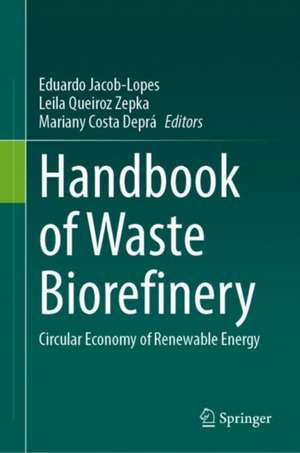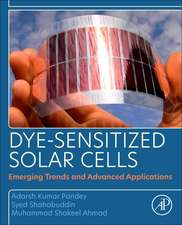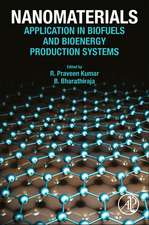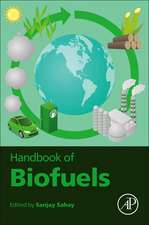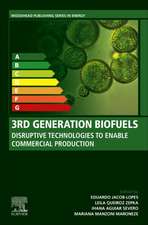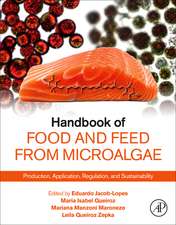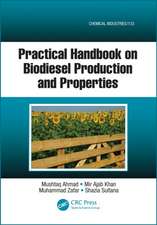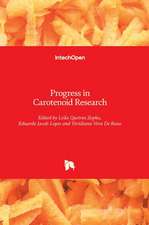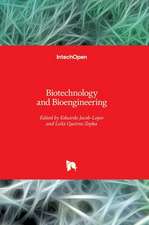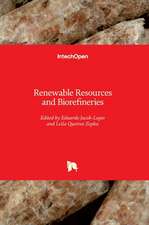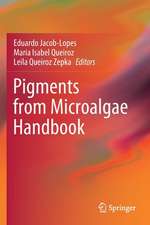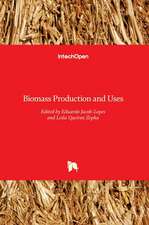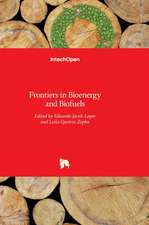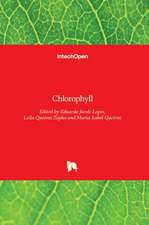Handbook of Waste Biorefinery: Circular Economy of Renewable Energy
Editat de Eduardo Jacob-Lopes, Leila Queiroz Zepka, Mariany Costa Depráen Limba Engleză Hardback – sep 2022
This handbook is divided into four parts. First, the reader is introduced to the fundamentals and recent trends of waste-to-energy technologies. The second part describes in detail the current status, challenges, and potential of the different feedstocks used for waste-to-energy conversion. Here, municipal solid waste, sewage sludge, oils and greases generated during food preparation, industrial wastewaters, and agricultural wastes, to name a few, are introduced.
In the third part, numerous waste-to-energy technologies are discussed in detail, including anaerobic digestion, composting, gasification, plasma technology, thermal cracking, and others. Advantages and optimization potentials of these technologies for efficient residue management, quality and yield are highlighted.
Finally, the handbook discusses social, environmental and economic aspects of waste-to-energy biorefinery technologies. Readers will learn more about the major bottlenecks and solutions in bioenergy commercialization, the logistics of biomass supply and the carbon footprint of waste biorefineries. The ideas and technologies presented in this book contribute to the UN Sustainable Development Goal (SDG) of "Affordable and Clean Energy".
This book is a useful reference for postgraduate students and researchers interested in biorefinery and biofuel technologies, both in academia- and commercial laboratories. Early career scientists can use it to fast track into the field. Advanced scientists will find it helpful in gaining a broader overview of the field beyond their area of specialization.
| Toate formatele și edițiile | Preț | Express |
|---|---|---|
| Paperback (1) | 1251.19 lei 6-8 săpt. | |
| Springer International Publishing – 2 sep 2023 | 1251.19 lei 6-8 săpt. | |
| Hardback (1) | 1257.97 lei 6-8 săpt. | |
| Springer International Publishing – sep 2022 | 1257.97 lei 6-8 săpt. |
Preț: 1257.97 lei
Preț vechi: 1534.11 lei
-18% Nou
Puncte Express: 1887
Preț estimativ în valută:
240.71€ • 251.100$ • 199.17£
240.71€ • 251.100$ • 199.17£
Carte tipărită la comandă
Livrare economică 05-19 aprilie
Preluare comenzi: 021 569.72.76
Specificații
ISBN-13: 9783031065613
ISBN-10: 3031065611
Pagini: 1014
Ilustrații: XI, 1014 p. 1 illus.
Dimensiuni: 155 x 235 mm
Greutate: 1.6 kg
Ediția:1st ed. 2022
Editura: Springer International Publishing
Colecția Springer
Locul publicării:Cham, Switzerland
ISBN-10: 3031065611
Pagini: 1014
Ilustrații: XI, 1014 p. 1 illus.
Dimensiuni: 155 x 235 mm
Greutate: 1.6 kg
Ediția:1st ed. 2022
Editura: Springer International Publishing
Colecția Springer
Locul publicării:Cham, Switzerland
Cuprins
Table of contents
Part IV - Criteria for policy, social, environmental, intellectual property, and economic aspects
Part I – Fundamentals
Chapter 1: Principles, concepts, and recent trends applied to the waste biorefineries
L. J. Corrêa, Federal University of Lavras, Brazil
Contact: luciano.correa@ufla.br
Chapter 2: Zero waste biorefinery
B. Cheirsilp, Department of Industrial Biotechnology, Thailand
Contact: benjamas.che@psu.ac.th
Chapter 3: Waste biorefinery facilities: The feedstock choice
M.M. Maroneze and L.Q. Zepka, National Autonomous University of Mexico and Federal University of Santa Maria, Brazil-Mexico
Contact: mariana_maroneze@hotmail.com
Contact: zepkaleila@yahoo.com.br
Chapter 4: Waste biorefinery in the context of the 4.0 industry
J. Zahn, Dupont Tate & Lyle Bioproducts, USA
Contact: James.A.Zahn@dupont.com
Chapter 5: Innovative markets from waste materials
M. E. Dal-Poz, Faculty of Applied Sciences, Administration and Institute of Economics - IE, UNICAMP, Brazil
Contact: ester.dalpoz@fca.unicamp.br
Chapter 6: Pretreatment emerging technologies applied to waste biorefinery
A. Jaiswal, School of Food Science & Environmental Health, Dublin, Ireland
Contact: amit.jaiswal@tudublin.ie
Chapter 7: Step forward on waste biorefineries: Technology bottlenecks and perspective on commercialization
S. K. Maity Indian Institute of Technology Hyderabad, Kandi, India
Contact: sunil_maity@che.iith.ac.in
Part II – Feedstocks
Chapter 8: Municipal solid wastes
H. A. Aziz, School of Civil Engineering, Universiti Sains Malaysia, Malaysia
Contact: cehamidi@usm.my
Chapter 9: Sewage sludge domestic
K. Mohanty, Indian Institute of Technology Guwahati,IndiaContact: kmohanty@iitg.ac.in
Chapter 10: Fats, oils and greases (FOG)
S. C. Popat, Department of Environmental Engineering and Earth Sciences, Clemson University, USA
Contact: spopat@clemson.edu
Chapter 11: Industrial wastewaters
P. Jha, Amity Institute of Biotechnology Amity University, Kolkata, India
Contact: priyanka.bt.jha@gmail.com
Chapter 12: Energy economics of wastewater treatment
L.A.A.F. Al-Hadidi, King Fahd University of Petroleum and Minerals, Saudi Arabia
Contact: lhadidi@kfupm.edu.sa
Chapter 13: Food wastes
T. I. J. Dugmore, Green Chemistry Centre of Excellence, University of York, UK
Contact: tom.dugmore@york.ac.uk
Chapter 14: Agricultural waste-derived
O.E. Diemuodeke, Faculty of Engineering, University of Port Harcourt
Rivers State, Nigeria.
Contact: ogheneruona.diemuodeke@uniport.edu.ng
Chapter 15: Livestock wastes
A. Cárdenas, Leibniz-Institut für Agrartechnik und Bioökonomie Germany
Contact: ACardenas@atb-potsdam.de
Chapter 16: Forestry residues
D.A. Gatto, Engineering Center, Federal University of Pelotas, Brazil
Contact: darcigatto@yahoo.com
Chapter 17: Microalgae biomass
R. Kataki, Department of Energy Tezpur, University Tezpur, India
Contact: rupamkataki@gmail.com
Chapter 18: Yeast biomass
E.N.O. Junior, Federal University of São João del Rei, Brazil
Contact: eniobio@ufsj.edu.br
Chapter 19: Waste-to-Chemicals
A. Jayaseelan, Center for Waste Management, Institute of Science and Technology, India
Contact: arunjayaseelan93@gmail.com
Part III - Waste to energy-food-feed-chemical-material technologies (WtEFFCM-Tech)
Chapter 20: Anaerobic digestion technologies
S. Baroutian, Department of Chemical & Materials Engineering, The University of Auckland, New Zealand
Contact: s.baroutian@auckland.ac.nz
Chapter 21: Fermentation
D. Farias, Toulouse Biotechnology Institute, France
Contact: danielefarias_@hotmail.com
Chapter 22: Composting
A. Sahu, ICAR- Indian Institute of Soil Science, Bhopal 462038, India
Contact: ashaars.iiss@gmail.com
Chapter 23: Pyrolysis
S. Ghysels, Department of Green Chemistry and Technology, Ghent University, Belgium
Contact: Stef.Ghysels@ugent.be
Chapter 24: Gasification
S. Nandi, Savitribai Phule Pune University, Ganeshkhind, India
Contact: somnath.nandi11@gmail.com
Chapter 25: Incineration and open waste burning
B. Das, Central Department of Environmental Science, Tribhuvan University, Nepal
Contact: bhupenids@gmail.com
Chapter 26: Torrefaction
T.A. Mamvura, College of Engineering and Technology, Botswana
Contact: atmamvura@gmail.com
Chapter 27: Hydrothermal liquefaction
R. Cuevas-García, Universidad Nacional Autónoma de México, Mexico
Contact: cuevas@unam.mx Chapter 28: Landfill gas utilization
A.N. Srivastava, Indian Institute of Technology Delhi, India
Contact: abhishekiitdelhi17@gmail.com
Chapter 29: Plasma technology
L. Agun, Universiti Teknologi Malaysia, Malaysia
Contact: lindaagun@yahoo.com
Chapter 30: Thermal cracking
A. Al-Absi, University of Calgary, Canada
Contact: Akramalabsi75@gmail.com
Chapter 31: Hydrothermal carbonization
E. Bevan, The University of Edinburgh, UK
Contact: eloise.alice.rose@gmail.com
Chapter 32: Microbial fuel cells
R. Banu, Regional Centre of Anna University, India
Contact: rajeshces@gmail.com
Chapter 33: Political challenges of circular economy
L.A. Swatuk, University of Waterloo, Canada
Contact: lswatuk@uwaterloo.ca
Chapter 34: Legal incentives for green technologies and circular economy
R. Ballardini University of Lapland, Finland
Contact: Rosa.Ballardini@ulapland.fi
Chapter 35: Socio-political acceptance of waste reutilization
C.H. Choong, Universiti Teknologi Malaysia, Malaysia
Contact: honchoong915@gmail.com
Chapter 36: Strategy and design of innovation policy road mapping for waste biorefineries
T. Bhaskar, Indian Institute of Petroleum, India
Contact: thalladab@yahoo.com
Chapter 37: Life cycle assessment on waste biorefineries
M. Thonsem, Department of Environmental Science, Aarhus University Denmark
Contact: mth@envs.au.dkChapter 38: Exergy analysis of waste biorefineries
C. Ofori-Boateng, School of Chemical Engineering, Universiti Sains Malaysia, Malaysia
Contact: cyndykote@yahoo.com
Chapter 39: Carbon footprint on waste biorefineries
M.C. Deprá and E. Jacob-Lopes, Federal University of Santa Maria, BrazilContact: marianydepra@gmail.com
Contact: ejacoblopes@gmail.com
Chapter 40: Innovation management on waste biorefineries
J.D.M. Martins, Lisbon Higher Institute of Accounting and Administration, Portugal
Contact: zdmmartins@gmail.com
Chapter 41: Research, development, and innovation on biorefineries
K. Zhao, Dalian Maritime University, China
Contact: kai.zhao@hotmail.fr
Chapter 42: Industrial economy and technological management in the context of waste biorefineries
O. Turgut, Norwegian University of Science and Technology, Norway
Contact: ozgu.turgut@ntnu.no
Chapter 43: Socioeconomic aspects of the waste biorefineries
A. Kumar, Lovely Professional University, India
Contact: kumarajaybiotech@gmail.com
Chapter 44: The bioeconomy of waste biorefineries
M. Kircher, KADIB Kircher Advice in Bioeconomy, Germany
Contact: kircher@kadib.de
Chapter 45: Techno-economic aspects of waste biorefineries
A. Halog, The University of Queensland, Australia
Contact: a.halog@uq.edu.au
Chapter 46: Scale-up of waste biorefineries systems
C.A.O. Filho, National Biorenewables Laboratory, Brazil
Contact: carlos.filho@lnbr.cnpem.br
Notă biografică
Prof. Eduardo Jacob-Lopes is currently associate professor at the Department of Food Technology and Science, Federal University of Santa Maria, Brazil. He has more than 18 years of teaching and research experience. He is a technical and scientific consultant of several companies, agencies, and scientific journals. He has more than 600 publications/communications and has registered 15 patents. His research interest includes biotechnology and bioengineering with emphasis on environmental biotechnology.
Prof. Leila Queiroz Zepka is currently an associate professor at the Department of Food Technology and Science, Federal University of Santa Maria, Brazil. She has more than 18 years of teaching and research experience. She is a technical and scientific consultant of several companies, agencies and scientific journals. She has 500 publications/communications and has registered 11 patents. Her research interest includes microalgal biotechnology with emphasis on biomolecules and novel products.
Prof. Leila Queiroz Zepka is currently an associate professor at the Department of Food Technology and Science, Federal University of Santa Maria, Brazil. She has more than 18 years of teaching and research experience. She is a technical and scientific consultant of several companies, agencies and scientific journals. She has 500 publications/communications and has registered 11 patents. Her research interest includes microalgal biotechnology with emphasis on biomolecules and novel products.
Dr. Mariany Costa Deprá is currently a researcher at the Department of Food Science and Technology, Federal University of Santa Maria, Brazil. She is a technical and scientific consultant of companies and scientific journals.With more than 100 publications/communications, her research interest includes process engineering with emphasis on sustainability metrics and indicators.
Textul de pe ultima copertă
This handbook discusses the latest developments in biorefinery technologies for waste-to-energy conversion. The growing global population and the accompanying increase in consumption and waste production make it urgent to find the best possible use of our resources. A sustainable waste management under the biorefinery concept has great potential to support a sustainable circular economy and green energy production.
This handbook is divided into four parts. First, the reader is introduced to the fundamentals and recent trends of waste-to-energy technologies. The second part describes in detail the current status, challenges, and potential of the different feedstocks used for waste-to-energy conversion. Here, municipal solid waste, sewage sludge, oils and greases generated during food preparation, industrial wastewaters, and agricultural wastes, to name a few, are introduced.
In the third part, numerous waste-to-energy technologies are discussed in detail, including anaerobic digestion, composting, gasification, plasma technology, thermal cracking, and others. Advantages and optimization potentials of these technologies for efficient residue management, quality and yield are highlighted.
Finally, the handbook discusses social, environmental and economic aspects of waste-to-energy biorefinery technologies. Readers will learn more about the major bottlenecks and solutions in bioenergy commercialization, the logistics of biomass supply and the carbon footprint of waste biorefineries. The ideas and technologies presented in this book contribute to the UN Sustainable Development Goal (SDG) of "Affordable and Clean Energy".
This book is a useful reference for postgraduate students and researchers interested in biorefinery and biofuel technologies, both in academia- and commercial laboratories. Early career scientists can use it to fast track into the field. Advanced scientists will find it helpful in gaining a broader overview of the field beyond their area of specialization.
In the third part, numerous waste-to-energy technologies are discussed in detail, including anaerobic digestion, composting, gasification, plasma technology, thermal cracking, and others. Advantages and optimization potentials of these technologies for efficient residue management, quality and yield are highlighted.
Finally, the handbook discusses social, environmental and economic aspects of waste-to-energy biorefinery technologies. Readers will learn more about the major bottlenecks and solutions in bioenergy commercialization, the logistics of biomass supply and the carbon footprint of waste biorefineries. The ideas and technologies presented in this book contribute to the UN Sustainable Development Goal (SDG) of "Affordable and Clean Energy".
This book is a useful reference for postgraduate students and researchers interested in biorefinery and biofuel technologies, both in academia- and commercial laboratories. Early career scientists can use it to fast track into the field. Advanced scientists will find it helpful in gaining a broader overview of the field beyond their area of specialization.
Caracteristici
Examines numerous waste-to-energy technologies in detail
Provides an overview of the main feedstock choices
Reviews social, environmental and economic aspects of waste-to-energy biorefinery technologies
Provides an overview of the main feedstock choices
Reviews social, environmental and economic aspects of waste-to-energy biorefinery technologies
